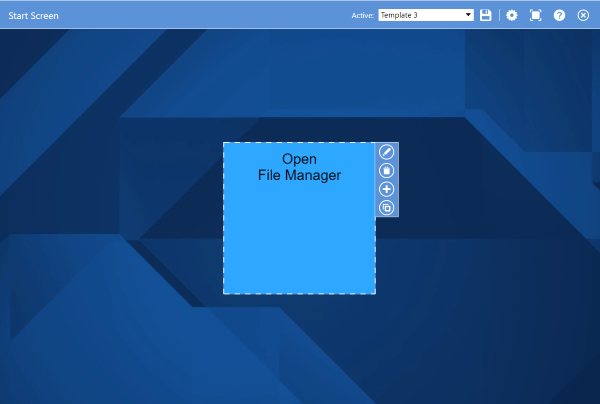This time we are going to have a look at how to start the SiteKiosk File Manager directly from the SiteKiosk Start Screen. But in opposite to the older article here we now also make it work when using the Start Screen with Chrome Browser skin.
First we need to create a local JavaScript file that takes care of the task of opening the File Manager. The code for that file can look like this:
function openFileManager(){
//Defines the available Window styles for the File Manager window
var WS_OVERLAPPED = 0x00000000;
var WS_MAXIMIZEBOX = 0x00010000;
var WS_MINIMIZEBOX = 0x00020000;
var WS_THICKFRAME = 0x00040000;
var WS_SYSMENU = 0x00080000;
var WS_BORDER = 0x00800000;
var WS_CAPTION = 0x00C00000;
var WS_MAXIMIZE = 0x01000000;
var WS_MINIMIZE = 0x20000000;
var WS_POPUP = 0x80000000;
var WS_OVERLAPPEDWINDOW = WS_OVERLAPPED | WS_CAPTION | WS_SYSMENU | WS_THICKFRAME | WS_MINIMIZEBOX | WS_MAXIMIZEBOX;
var WS_EX_TOOLWINDOW = 0x00000080;
//Creates the File Manager window and assigns its settings
var mediabox = SiteKiosk.SiteKioskUI.CreateHTMLDialog();
mediabox.URL = SiteKiosk.SiteKioskDirectory + "skins\\public\\Media\\FileManager\\Selector.html";
mediabox.Styles = 13565952;
mediabox.Icon = SiteKiosk.SiteKioskDirectory + "skins\\public\\Media\\FileManager\\Img\\Icons\\fms_ico.ico";
mediabox.Width = 1024;
mediabox.Height = 700;
mediabox.ExStyles = 0;//
mediabox.Border = true;
mediabox.Type = "FileManagerDlg";
mediabox.TopMostWindow = false;
mediabox.CloseOnInput = false;
mediabox.Parent = SiteKiosk.WindowList.MainWindow.SiteKioskWindow.Window;
mediabox.ShowDialog();
}
Just copy and paste the code to an editor and save it as for example as "OpenFileManager.js" at "…\SiteKiosk\Html".
Next it's time to open the SiteKiosk configuration and adding this script file at "Start Page & Browser-->Advanced-->On startup of SiteKiosk execute the following script file".
Under "Start Page & Browser" select the Start Screen. Click on "Customize" and open the Start Screen editor. Select one of the three templates and create a new HTML Widget link element. Edit the element and add the following code that calls the external script function openFileManager:
<script>
(new Function(_siteKiosk.getSiteKioskObjectModelCode()))();
function openFileManagerExt() {
_siteKiosk.objectModel.callHostFunction("system.windows.skLegacy.executeScript", "SiteKiosk.ScriptDispatch.openFileManager();");
}
</script>
<div style="background-color:2DA7FF;height:100%;padding:10px;font-family:Arial;cursor:pointer;" onclick="openFileManagerExt();">
<div style="height:100%;width:100%;font-size:30px;text-align:center;margin-top:3%;">Open<br/>File Manager</div>
</div>
The function OpenFileManagerExt is "Using the Classic SiteKiosk Object Model in SiteKiosk Windows Chrome Browser" in combination with the "ScriptDispatch Object" from Classic Object Model to call the external script function "openFileManager".

In the <div></div> part you can use HTML code of your choice to change the element to your liking (text, color, etc.).
General Note:
Which directories are displayed in the File Manager (download folder, etc.) must be specified beforehand under "-->Files & Downloads", while you have selected the Metro IE Skin under "-->Start Page & Browser".
The path for the download folder should match the download folder in the Chrome Browser skin.
Since the download folder matches with the default settings "C:\Users\Public\Documents\SiteKiosk", you normally only need to activate the File Manager and Downloads.
At the end it should look like this when the File Manager is opened:
